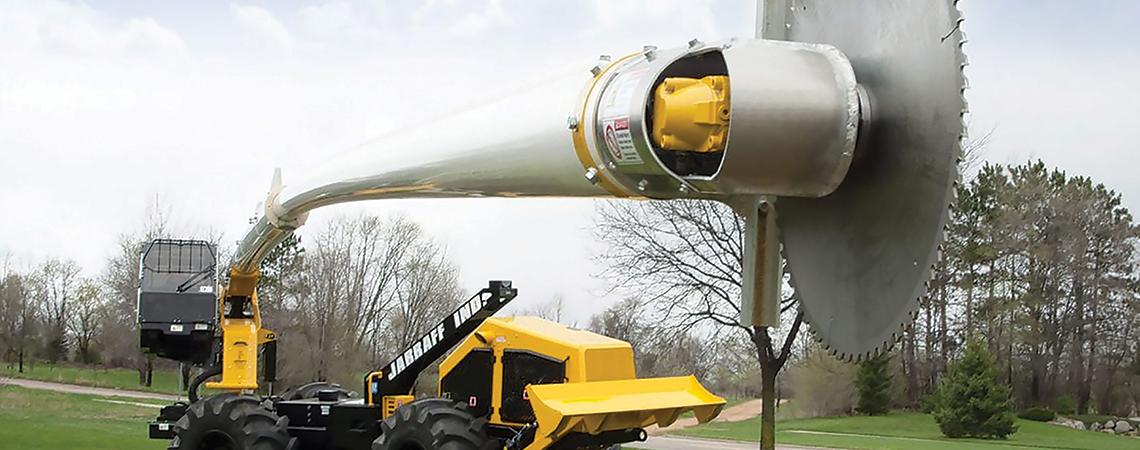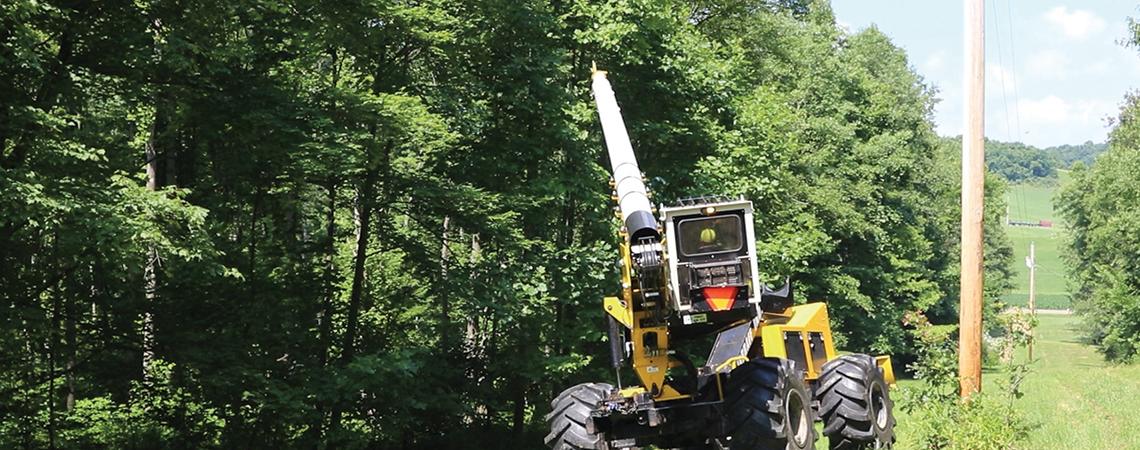It’s a common sight, especially during the spring and summer growing season — crews cutting away tree limbs and foliage that have gotten too close to nearby power lines.
Though the work is often arduous, the lineworkers conducting right-of-way (ROW) maintenance are an essential part of providing safe, affordable, and reliable electricity to consumer-members. “The ROW workers are the protectors of the power lines,” says Ken Hunter, line superintendent for The Frontier Power Company, the Coshocton-based electric distribution cooperative. “Without them, nothing else could function.”
Jarraff Industries’ all-terrain tree trimmer (far left) features a 2-foot saw blade at the end of a 75-foot arm to trim out-of-the-way vegetation.
Generally, anything within a set distance on either side of the lines, as well as above and below the lines, must come down to prevent contact — especially when storms roll through. Without ROW maintenance, obtrusive branches and limbs often can be blown into the lines, creating dangerous and costly power outages.
That maintenance generally involves co-op employees or contractors who maneuver alongside power lines in a bucket truck and remove vegetation with a chainsaw. However, when the foliage becomes too thick or terrain is impassable, they may need to call in less-traditional measures.
Frontier Power, for example, uses a spray crew, which carries a 200- to 300-gallon tank of water and chemicals used to regulate the growth. The real marvel, though, is a machine called the Jarraff — a long-necked tool that looks like something straight out of a Dr. Seuss book. The Jarraff moves on either all-terrain tires or tracks and has a neck that extends up to 75 feet with a 24-inch, 180-degree-rotating precision saw blade attached.
Hunter says the Jarraff is the most cost-effective method available, considering the terrain involved. “The crew can cover about 1,000 feet per day, far more than could be done with chainsaws and a bucket truck.”
While the giraffe-inspired machine is efficient, it does have its drawbacks. The machine can only be used to cut trees on the sides of wires, leaving trees under the power lines for workers and tree cutters. In that case, workers climb trees with chainsaws, handsaws, and rope to remove the encroaching foliage. “We do the same thing every day, but everything is different as to how you do it,” says Hunter.
In southeast Ohio, Rio Grande-based Buckeye Rural Electric Cooperative uses an even more dramatic method to reach areas that would otherwise be completely inaccessible. A helicopter dangles an enormous chainsaw and flies alongside power lines to eliminate overgrown brush and foliage.
The chainsaw’s side-trim blade allows the helicopter to remove overhang around the power lines, while the angled saw can cut down dead or dangerous trees. Ed Mollohan, vice president of operations at Buckeye Rural, says the helicopter is incredibly expensive, but saves a lot of time. “What takes the helicopter a week to do would take a ground crew six months.”
Not only that, but the operators are so skilled that they can cut down trees using the angled saw without anything falling on the power lines. “There’s definitely a lot more reward than risk,” Mollohan says. “The use of the helicopter reduces outages significantly. We cut 3,000 trees off of right-of-way last year and about two-thirds of that was done by the helicopter.” The helicopters are often used in thick valleys and hills or national forests to reduce damage to nature that a truck might cause.
The helicopter cannot be used near homes or roads, and it has a few drawbacks: one, it’s costly; it’s also potentially dangerous, though new features allow the saw to detach from its tether when it gets caught or hung up, which significantly increases the safety of the pilot and helicopter itself.
Mollohan says the helicopter has been the co-op’s most effective tool in battling the emerald ash borer, a beetle whose larvae kill ash trees. Hundreds of trees killed by the ash borer have had to be cut down so they don’t fall on power lines.
Mount Gilead-based Consolidated Cooperative employs an arborist on staff to help with ROW planning and healthy trimming practices. The arborist, David Tidd, says part of his job is to ensure the protection of trees as much as possible. “All of our specifications are done to International Society of Arboriculture standards, which means we do our best to make proper pruning cuts that are in the best interest of the tree.”
While some members occasionally object to having trees cut to maintain the ROW, Tidd says it’s always done carefully and with a plan. “We just received our 11th annual award from the Arbor Day Foundation for meeting safe and healthy cutting requirements. We don’t go out and remove just any old tree; we identify the specific needs and removals that are necessary. Our cutting is about what’s healthiest for the tree, and that’s not just simply doing what looks the prettiest.”











